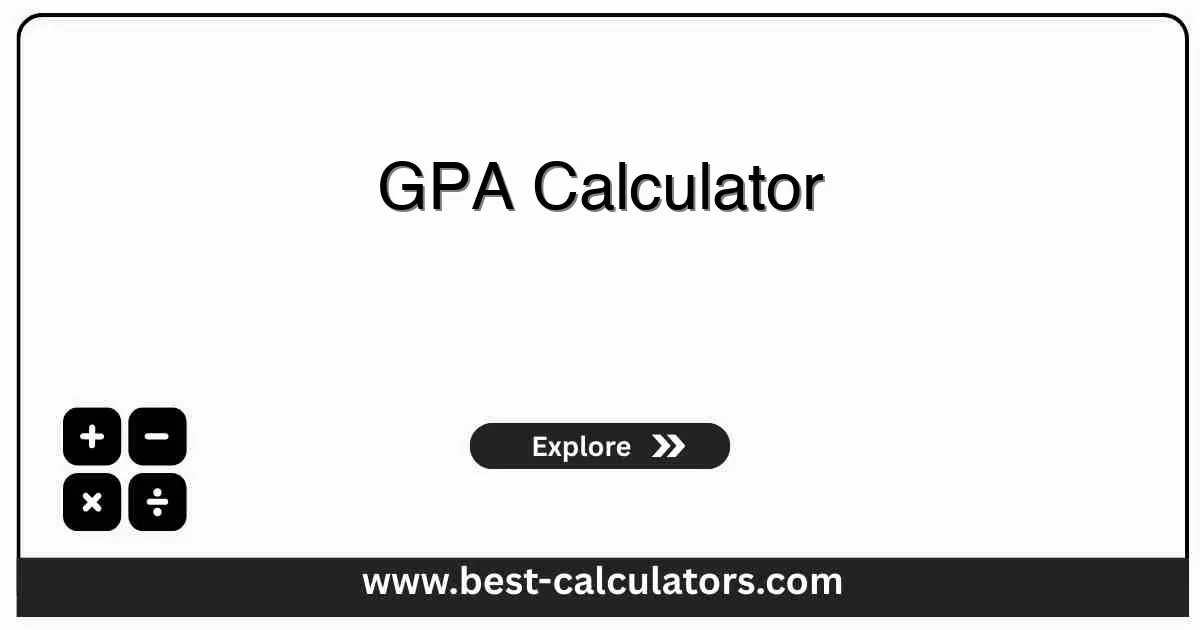GPA Calculator - Calculate Grade Point Average
Free GPA calculator to compute your Grade Point Average based on course grades and credit hours. Track academic performance and plan for college admissions
GPA Calculator
Results
Grade Scale
How to Use This Calculator
Select GPA Type
Choose between semester GPA for current term or cumulative GPA for all terms
Enter Course Details
Input course names, letter grades, and credit hours for each class
Add More Courses
Use the add button to include additional courses as needed
Calculate GPA
Click calculate to see your GPA and detailed breakdown
Understanding GPA
GPA (Grade Point Average) is a standardized measure of academic performance used by schools, colleges, and universities to evaluate student achievement.
What is GPA?
GPA converts letter grades into numerical values and calculates a weighted average based on credit hours. Most institutions use a 4.0 scale where A=4.0, B=3.0, C=2.0, D=1.0, and F=0.0.
If you need to convert your GPA to a percentage, try our percentage calculator.
For calculating averages across different subjects, our average percentage calculator can be very useful.
If you're working with fractions in your grades, check out our fraction calculator for precise calculations.
Why GPA Matters
GPA is crucial for college admissions, scholarship eligibility, academic standing, graduate school applications, and job opportunities. It provides a standardized way to compare academic performance.
Understanding Your Results
Your GPA calculation provides valuable insights into your academic performance and helps you track progress toward educational goals.
Semester GPA
Semester GPA reflects your performance for a single term. It helps identify improvements or declines in academic performance over time.
Cumulative GPA
Cumulative GPA includes all coursework completed. It's the most important metric for college admissions and academic standing evaluations.
Grade Point Conversion
Each letter grade corresponds to grade points: A+=4.0, A=4.0, A-=3.7, B+=3.3, B=3.0, B-=2.7, C+=2.3, C=2.0, C-=1.7, D+=1.3, D=1.0, D-=0.7, F=0.0.
Important Considerations and Limitations
While our GPA calculator provides accurate results, it's important to understand institutional variations and consider the context of your academic journey.
1. Institutional Variations
Different schools may use slightly different grade scales. Some institutions award A+ grades 4.3 points, while others maintain the standard 4.0 scale.
2. Weighted vs. Unweighted
Our calculator uses the standard unweighted 4.0 scale. Honors, AP, or IB courses may receive extra points at some institutions, allowing GPAs above 4.0.
3. Context Matters
GPA should be interpreted alongside course rigor, improvement trends, and extenuating circumstances. A 3.5 GPA with challenging coursework may be more impressive than a 3.8 GPA with easier courses.

Frequently Asked Questions (FAQ)
Q: What is a GPA calculator?
A: A GPA calculator is a tool that helps students calculate their Grade Point Average based on their course grades and credit hours. It converts letter grades to grade points and computes the weighted average to determine cumulative academic performance.
Q: How do you calculate GPA?
A: To calculate GPA, multiply each course's grade points by its credit hours, sum all the grade points, and divide by the total credit hours. For example, if you earned an A (4.0) in a 3-credit course and a B (3.0) in a 4-credit course: (4.0×3 + 3.0×4) / (3+4) = 3.43 GPA.
Q: What is the difference between weighted and unweighted GPA?
A: An unweighted GPA uses a standard 4.0 scale regardless of course difficulty. A weighted GPA accounts for honors, AP, or IB courses by adding extra points (e.g., A in regular course = 4.0, A in AP course = 5.0). Weighted GPAs can exceed 4.0.
Q: How do you calculate cumulative GPA?
A: Cumulative GPA includes all courses taken throughout your academic career. Add the total grade points from all semesters and divide by the total credit hours attempted. For example, if you had 45 grade points over 15 credits in semester 1 and 52 grade points over 16 credits in semester 2: (45+52)/(15+16) = 3.13 cumulative GPA.
Q: What is considered a good GPA?
A: A good GPA varies by context. Generally, 3.0+ is considered satisfactory, 3.5+ is strong, and 3.7+ is excellent. For competitive colleges, aim for 3.8+. Graduate programs often expect 3.5+ depending on the field. Employers typically look for 3.0+ as a baseline.
Q: Can GPA be improved?
A: Yes, GPA can be improved by earning higher grades in future courses. Since GPA is cumulative, improvement happens gradually. Focus on performing well in courses with higher credit hours, as they have more impact on your overall GPA.